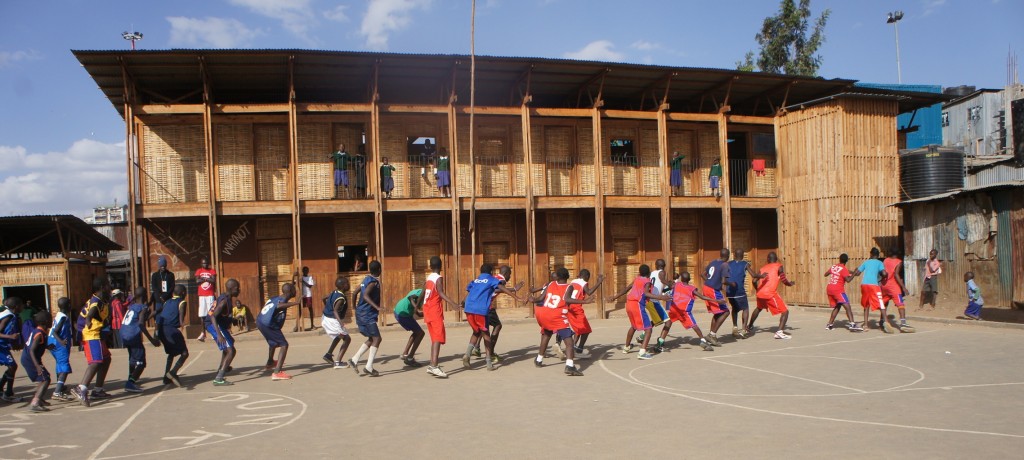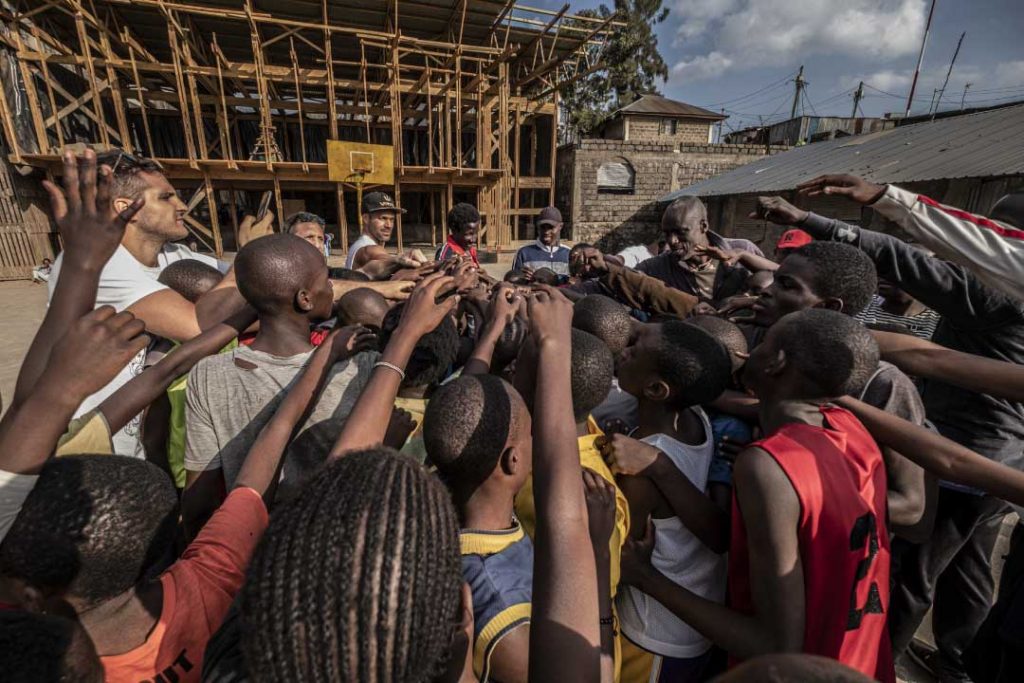
The first time I entered Mathare was on Thursday, 25 March 2004, these are the impressions I gathered in my diary: ‘We walked for hours under a boiling sun, we walked along every street (clearly dirt) and path, we passed among the open sewers that flowed in part of the houses, it seems to me that I have never been in an uglier place…yet they tell me that today we have only seen ¼ of the slum, that this is not the ugliest and most dangerous part! On that day I meet and am accompanied by Dominic Otieno. Let’s clarify the character. Dominic, aka Mimmo, honestly is to basketball as pineapple is to pizza…he has nothing to do with it. He’s dwarf and tiny.
On the same day I am lucky enough to have another important meeting. At 4 in the afternoon I leave and after 3 minibuses and almost 2 hours of travelling (for a total of 20 at the most) I arrive at the Kivuli Centre in time for basketball training. As a child basketball was my passion but I was too short. When finally at the age of 17 I was tall enough and started to play well I broke my knee cruciate for the first time. When I arrive in Kenya my basketball career is almost over, I enjoy playing with an old team in Padova in the first category. In Kenya objectively I am one of the best in the team that plays in the Kenyan B series. I have to clarify a few things. First of all the field is as big as half a field and made up of many annoying and quite dangerous squares…6 years later maybe it is not by chance that here I will also break the cruciate of my other knee. Another peculiarity is the iron fixed by choice at a height of 3.24 metres. With a typical Bronx-in-Salz-African concept, the idea was to get to dunk at that height and then dunk better during normal games. I think I managed to touch the iron a couple of times but a couple of hunks with dynamite on their feet managed to dunk. The game revolved around 3 principles: breaking all the rules of passing and double dribbling, trying to dunk, not defending.
These two encounters are important for me and I assume for Slums Dunk as well, since 10 years later the construction of the first Slums Dunk basketball court will start in Mathare.
But let’s proceed in time. A few days in 2005 the Karibu Afrika association was opened with the intention of promoting cultural exchanges and cooperation projects in Kenya.
In 2006 Dominic opens the Whynot Junior Academy, a typical slum school I would say. He started by teaching the children in his house, doing some afternoon tutoring before going with them to football practice. After some time he decided to move the activities first to 1 rented shack, 3 metres x 2. Then in 2 shacks and finally in March 2008 in 3 shacks. The teaching is informal… but everything is informal in the shantytown. At least there is a semblance of education or at least the idea of not leaving the kids to hang around in the streets. At that point Karibu Afrika starts to look for a plot of land to house the school. Even then there was not much space in the shantytown and so the only suitable area was the ‘Mathare shithouse’. A terrible place…it was the open toilet of the slum but also quite a dangerous and violent area. We were only passing by before 5pm and it was a challenge to try and avoid the exits. A kind of ‘minefield’. Thanks to the good production of fertiliser, the humidity of the area and the sun reflected off the barracks, this area was home to some rather prolific plants including giant ‘organic’ banana trees.
The area bordered the Mathare River, better known as the Black River…yes, black river because of its colour, black. When they offered us land there, my hair stood on end. Before we started building the school we tried to ‘feel the ground’. It was amazing…the ground had a mix of soil, plastic bags, the usual fertiliser and all kinds of other waste (shoes, work tools, etc.) underneath. The first few days of work were a delirium: weeding, digging, clearing. The construction was well planned and in 3 weeks Whynot had a new home. 2 flashes. On the one hand the children of Whynot who, in spite of child labour, helped to build their school by carrying tons of stones down a hill as if it were a game. On the other Giancarlo was directing the work. Knowing neither English nor Swahili, the workers had learned the names of the tools in the Brescian dialect.
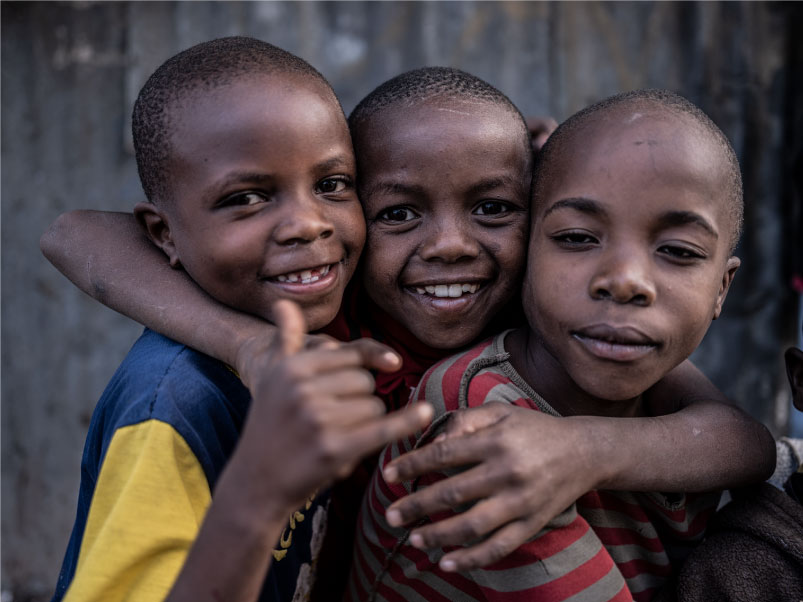
Right from the start the area around the Whynot began to change, various other people began to clean up the area, a clothes market opened, some Afro-pioneers began to cultivate in the area next to the river, the area was gradually cleaned up and reclaimed thanks mainly to the thousands of people who began to pass through. In 2009, the school needed more space, and with the help of Kahuria, the site manager with the recognisable 30-tooth smile… 32 minus 2, because he is missing the top two posts. The engineering work, which probably does not comply with any basic building law… and of physics, will bring the Whynot to the second floor for the first time.
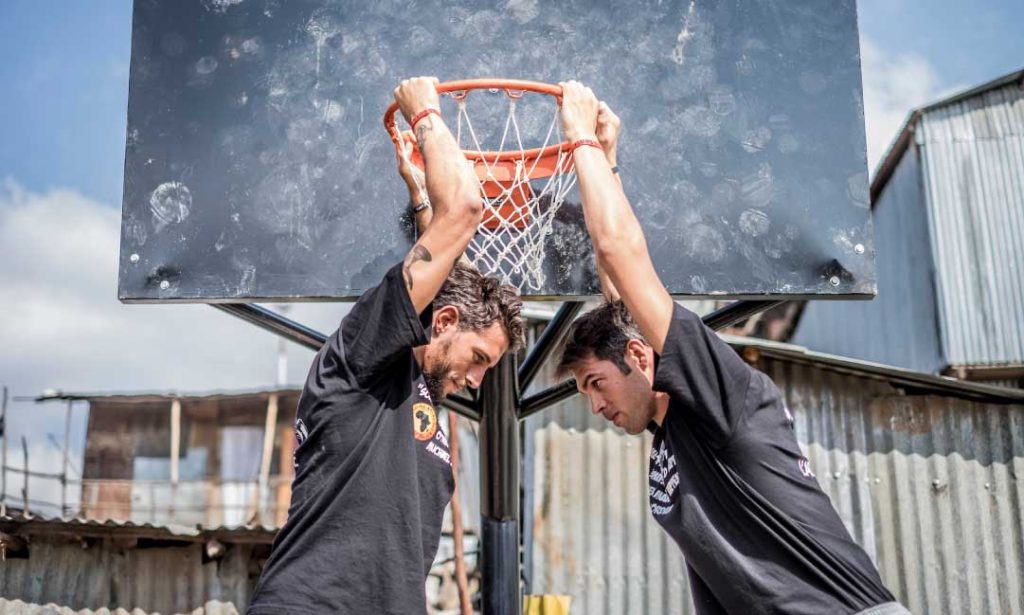
Nel 2010 un altro momento importante. Sostenuti dall’associazione L’Altropallone m’imbarco insieme a Francesco, un altro membro di Karibu Afrika, Dominic e altri 2 compagni di viaggio in un progetto-avventura che ci porta ad attraversare 8 paesi africani durante la coppa del mondo di calcio. Si parte dal Kenya e si arriva in Sud Africa. Ogni giorno realizziamo attivita’ educative e sportive per strada. Il progetto e’ un successo. Tornati da quel viaggio decidiamo di puntare tutto i nostri sforzi alla promozione dello sport come strumento per educare le comunita’ locali. Nel 2011 Francesco parla con un suo amico, Michele Carrea, che gli parla di un giocatore di pallacanestro di Teramo, italo-argentino, che vorrebbe fare un esperienza in Africa…vorrebbe far giocare a basket i bambini africani. Domanda ed offerta s’incontrano! Bruno coinvolge anche Tommy e con loro concordiamo di fare attivita’ con varie scuole e squadre di pallacanestro Kenyane. Chiediamo loro un contributo di 200 euro a testa cosi da organizzare il tutto al meglio. La serata prima del loro arrivo vado su internet per cercare di dare un volto a questi due baskettari. In internet al tempo c’eran veramente poche informazioni. Trovo giusto due righe e qualche statistica della lega basket ma poca roba. Inizio sinceramente ad avere un certo timore: ma non e’ che mi arrivan qui due giovani fighetti sportivi…paura! Alle 4 di mattina eccomi quindi in aeroporto ad aspettarli con un foglio A4 con scritti i loro nomi. Dall’aereo della Egypt air scendono vari personaggi: parecchi arabi, qualche americano, le hostess. Ad un certo punto, una spanna sopra a due vecchiette orientali vedo spuntare due ragazzi in canottiera, infradito e cappellino. Mi vergogno di aver portato il foglio A4…lo strappo in 3 secondi. La prima impressione conferma tutte le mie paure, due ragazzi giovani, pure belloccioni che mi arrivano in tenuta Miami Beach. Disperazione. Dal giorno dopo abbiam iniziato gli allenamenti e tutto e’ cambiato. Ho scoperto in Bruno e Tommy due persone speciali. Simpatici, adattabili e flessibili. Basta ricordare che nel 2011 li abbiam fatti dormire in una stanza di 9 metri quadrati in cui erano in camera in 3. Tommy e Bruno dormivano in un letto a castello…uscivan dal letto di 20 cm buoni. Da li e’ nata un amicizia e soprattutto e’ nato il progetto Slums Dunk. Il primo anno e’ stato un sopralluogo con attivita’ insieme a 10 squadre di pallacanestro e un torneo finale in centro a Nairobi. Dal 2011 iniziera’ a lavorare a Mathare ancha l’ONG Live in Slums che in 5 estati ricostruira’ su due piani la Whynot Junior Academy.
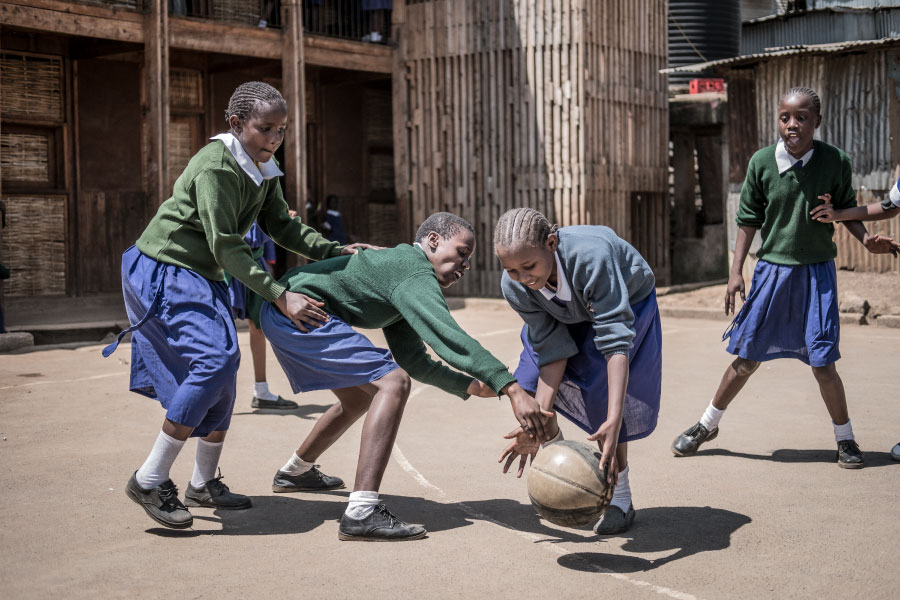
In 2012 we run our second camp, this time focusing our activities in Eastleigh, the Somali area of Nairobi. We begin to test the current model of Slums Dunk camps. In the morning activities with the coaches and in the afternoon activities with the boys. In addition to Tommy, there was also Michele Carrea, while Bruno was forced to stay in the box because of a knee injury. In 2013 we expanded the camp and involved 40 coaches, 20 in the basic course and 20 in the advanced course. We do the activities at the Utalj college where we have at our disposal 2 basketball courts with a view on the Mathare slum. Every day during the lunch break Bruno and the others go down to Mathare… that is where we would like to do the activities but we lack the raw material… a basketball court. It’s time for Slums Dunk to grow and we decide that our next camp in Kenya will be in Mathare, on our own basketball court.
Construction work on the basketball court begins in March 2014 under the leadership of Mr. Smile Kahuria. Some unforeseen events, caused by the terrain and the proximity of the river, slow down the construction a bit and increase the costs. By the time Bruno and the others arrive in July, everything is almost ready… except for the last layer of asphalt. The first day the irons are fixed. From the next day the basketball game begins. The difficulties are many because the playing field is not completely flat and because of the dust that constantly covers the floor. Balancing is a challenge! 1 month later we hire a local company to make the final layer of asphalt in 2 days.SONY DSC
In 2014 we also started a collaboration with World Friends who made their educators available to carry out health education activities in 10 schools in Mathare. In 2015 we also began a collaboration with the Anglo-American NGO TAG, which for the next 5 years will collaborate with Slums Dunk and World Friends with the project ‘Slums Dunk – Hoops for Kids’ for the development of education among the youth of Mathare through the use of basketball.
Today the basketball court and the Whynot Junior Academy are probably the most livable 750 square metres in the Mathate slum. The real achievement is not this, but rather the fact of having ‘rehabilitated’ an infamous area of Mathare. Around Whynot on the day it opened in September 2008 there was no other school within 50 metres, today there are at least 5 or 6. The area is now much more livable and the basketball court is the highlight of these years of work in Mathare.

